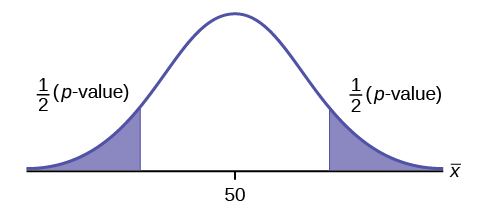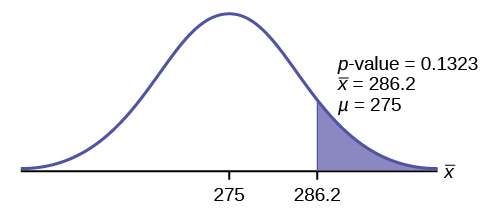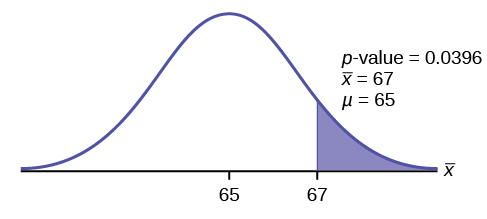Learning Outcomes
- Summarize full hypothesis test process for population proportions and means
- In a hypothesis test problem, you may see words such as “the level of significance is 1%.” The “1%” is the preconceived or preset α.
- The statistician setting up the hypothesis test selects the value of α to use before collecting the sample data.
- If no level of significance is given, a common standard to use is α = 0.05.
- When you calculate the p-value and draw the picture, the p-value is the area in the left tail, the right tail, or split evenly between the two tails. For this reason, we call the hypothesis test left, right, or two tailed.
- The alternative hypothesis, Ha, tells you if the test is left, right, or two-tailed. It is the key to conducting the appropriate test.
- Ha never has a symbol that contains an equal sign.
- Thinking about the meaning of the p-value: A data analyst (and anyone else) should have more confidence that he made the correct decision to reject the null hypothesis with a smaller p-value (for example, 0.001 as opposed to 0.04) even if using the 0.05 level for alpha. Similarly, for a large p-value such as 0.4, as opposed to a p-value of 0.056 (alpha = 0.05 is less than either number), a data analyst should have more confidence that she made the correct decision in not rejecting the null hypothesis. This makes the data analyst use judgment rather than mindlessly applying rules.
The following examples illustrate a left-, right-, and two-tailed test.
Example
Ho: μ = 5, Ha: μ < 5
Test of a single population mean. Ha tells you the test is left-tailed. The picture of the p-value is as follows:

TRY IT
H0: μ = 10, Ha: μ < 10
Assume the p-value is 0.0935. What type of test is this? Draw the picture of the p-value.
Solution:
left-tailed test

Example
H0: p ≤ 0.2 Ha: p > 0.2
This is a test of a single population proportion. Ha tells you the test is right-tailed. The picture of the p-value is as follows:

TRY IT
H0: μ ≤ 1, Ha: μ > 1
Assume the p-value is 0.1243. What type of test is this? Draw the picture of the p-value.
Example
This is a test of a single population mean. Ha tells you the test is two-tailed. The picture of the p-value is as follows.

TRY IT
H0: p = 0.5, Ha: p ≠ 0.5
Assume the p-value is 0.2564. What type of test is this? Draw the picture of the p-value.
Full Hypothesis Test Examples
Example
A college football coach thought that his players could bench press a mean weight of 275 pounds. It is known that the standard deviation is 55 pounds. Three of his players thought that the mean weight was more than that amount. They asked 30 of their teammates for their estimated maximum lift on the bench press exercise. The data ranged from 205 pounds to 385 pounds. The actual different weights were (frequencies are in parentheses) 205(3) 215(3)225(1) 241(2) 252(2) 265(2) 275(2) 313(2) 316(5) 338(2) 341(1) 345(2) 368(2) 385(1).
Conduct a hypothesis test using a 2.5% level of significance to determine if the bench press mean is more than 275 pounds.
Solution:
Set up the Hypothesis Test:
Since the problem is about a mean weight, this is a test of a single population mean.
H0: μ = 275
Ha: μ > 275
This is a right-tailed test.
Calculating the distribution needed:
Random variable: [latex]\overline{X}[/latex] = the mean weight, in pounds, lifted by the football players.
Distribution for the test: It is normal because σ is known. [latex]\overline{X}~N\left(275,\frac{55}{\sqrt{30}}\right)[/latex]
[latex]\overline{x}[/latex] = 286.2
σ =55 pounds (Always use σ if you know it.) We assume μ = 275 pounds unless our data shows us otherwise.
Calculate the p-value using the normal distribution for a mean and using the sample mean as input. p-value=P[latex]\left(\overline{x}>286.2\right)=0.1323[/latex].
Interpretation of the p-value: If H0 is true, then there is a 0.1331 probability (13.23%) that the football players can lift a mean weight of 286.2 pounds or more. Because a 13.23% chance is large enough, a mean weight lift of 286.2 pounds or more is not a rare event.

Compare α and the p-value:
α = 0.025 p-value = 0.1323
Make a decision: Since α <p-value, do not reject H0.
Conclusion: At the 2.5% level of significance, from the sample data, there is not sufficient evidence to conclude that the true mean weight lifted is more than 275 pounds.
HISTORICAL NOTE
The traditional way to compare the two probabilities, α and the p-value, is to compare the critical value (z-score from α) to the test statistic (z-score from data). The calculated test statistic for the p-value is –2.08. (From the Central Limit Theorem, the test statistic formula is z=[latex]\frac{\overline{x}-{\mu}_{X}}{(σ)}[/latex]. For this problem,[latex]\overline{x}[/latex] = 16,[latex]{/mu}_{X}[/latex] = 16.43 from the null hypothes is, [latex]{/mu}_{X}[/latex] = 0.8, and n = 15.) You can find the critical value for α = 0.05 in the normal table (see 15.Tables in the Table of Contents or use NORM.S.INV function in Excel). The z-score for an area to the left equal to 0.05 is midway between –1.65 and –1.64 (0.05 is midway between 0.0505 and 0.0495). The z-score is –1.645. Since –1.645 > –2.08 (which demonstrates that α > p-value), reject H0. Traditionally, the decision to reject or not reject was done in this way. Today, comparing the two probabilities α and the p-value is very common. For this problem, the p-value, 0.0187 is considerably smaller than α, 0.05. You can be confident about your decision to reject. The graph shows α, the p-value, and the test statistics and the critical value.

The p-value can easily be calculated in Excel or on the TI83/84..
Example
Statistics students believe that the mean score on the first statistics test is 65. A statistics instructor thinks the mean score is higher than 65. He samples ten statistics students and obtains the scores 65 65 70 67 66 63 63 68 72 71. He performs a hypothesis test using a 5% level of significance. The data are assumed to be from a normal distribution.
Solution:
Set up the hypothesis test:
A 5% level of significance means that α = 0.05. This is a test of a single population mean.
H0: μ = 65 Ha: μ > 65
Since the instructor thinks the average score is higher, use a “>”. The “>” means the test is right-tailed.
Determine the distribution needed:
Random variable: [latex]\overline{X}[/latex] = average score on the first statistics test.
Distribution for the test: If you read the problem carefully, you will notice that there is no population standard deviation given. You are only given n = 10 sample data values. Notice also that the data come from a normal distribution. This means that the distribution for the test is a student’s t.
Use tdf. Therefore, the distribution for the test is t9 where n = 10 and df = 10 – 1 = 9.
Calculate the p-value using the Student’s t-distribution:
p-value = P([latex]\overline{x}[/latex]> 67) = 0.0396.
Interpretation of the p-value: If the null hypothesis is true, then there is a 0.0396 probability (3.96%) that the sample mean is 65 or more.

Compare α and the p-value:
Since α = 0.05 and p-value = 0.0396. α > p-value.
Make a decision: Since α > p-value, reject H0.
This means you reject μ = 65. In other words, you believe the average test score is more than 65.
Conclusion: At a 5% level of significance, the sample data show sufficient evidence that the mean (average) test score is more than 65, just as the math instructor thinks.
The p-value can easily be calculated.
The sample mean and sample standard deviation are calculated as 67 and 3.1972 from the data, using the AVERAGE and STDEV.S functions respectively. Find the t test statistic [latex]t=\frac{\overline{X}-\mu}{s/ /sqrt{n}} = \frac{ 67-65}{3.1972/ /sqrt{10}} = 1.9782 [\latex]. Use =1-T.DIST(1.9782, 9, 1) = 0.0396.
TRY IT
It is believed that a stock price for a particular company will grow at a rate of $5 per week with a standard deviation of $1. An investor believes the stock won’t grow as quickly. The changes in stock price is recorded for ten weeks and are as follows: $4, $3, $2, $3, $1, $7, $2, $1, $1, $2. Perform a hypothesis test using a 5% level of significance. State the null and alternative hypotheses, find the p-value, state your conclusion, and identify the Type I and Type II errors.
[reveal-answer q="190855"]Show Solution[/reveal-answer] [hidden-answer a="190855"] Solution:
H0: μ = 5
Ha: μ < 5
p = 0.0082
Because p < α, we reject the null hypothesis. There is sufficient evidence to suggest that the stock price of the company grows at a rate less than $5 a week.
Type I Error: To conclude that the stock price is growing slower than $5 a week when, in fact, the stock price is growing at $5 a week (reject the null hypothesis when the null hypothesis is true).
Type II Error: To conclude that the stock price is growing at a rate of $5 a week when, in fact, the stock price is growing slower than $5 a week (do not reject the null hypothesis when the null hypothesis is false).
[/hidden-answer]
Example
Set up the hypothesis test:
The 1% level of significance means that α = 0.01. This is a test of a single population proportion. H0: p = 0.50 Ha: p ≠ 0.50
The words "is the same or different from" tell you this is a two-tailed test.
Calculate the distribution needed:
Random variable:P′ = the percent of of first-time brides who are younger than their grooms.
Distribution for the test: The problem contains no mention of a mean. The information is given in terms of percentages. Use the distribution for P′, the estimated proportion.
Other problems to try:
-
A teacher believes that 85% of students in the class will want to go on a field trip to the local zoo. She performs a hypothesis test to determine if the percentage is the same or different from 85%. The teacher samples 50 students and 39 reply that they would want to go to the zoo. For the hypothesis test, use a 1% level of significance.
First, determine what type of test this is, set up the hypothesis test, find the p-value, sketch the graph, and state your conclusion.
2.
The National Institute of Standards and Technology provides exact data on conductivity properties of materials. Following are conductivity measurements for 11 randomly selected pieces of a particular type of glass.
1.11; 1.07; 1.11; 1.07; 1.12; 1.08; 0.98; 0.98 1.02; 0.95; 0.95
Is there convincing evidence that the average conductivity of this type of glass is greater than one? Use a significance level of 0.05. Assume the population is normal.
4.
According to the US Census there are approximately 268,608,618 residents aged 12 and older. Statistics from the Rape, Abuse, and Incest National Network indicate that, on average, 207,754 rapes occur each year (male and female) for persons aged 12 and older. This translates into a percentage of sexual assaults of 0.078%. In Daviess County, KY, there were reported 11 rapes for a population of 37,937. Conduct an appropriate hypothesis test to determine if there is a statistically significant difference between the local sexual assault percentage and the national sexual assault percentage. Use a significance level of 0.01.
5.
Suppose a consumer group suspects that the proportion of households that have three cell phones is 30%. A cell phone company has reason to believe that the proportion is not 30%. Before they start a big advertising campaign, they conduct a hypothesis test. Their marketing people survey 150 households with the result that 43 of the households have three cell phones.
6.
Concept Review
The hypothesis test itself has an established process. This can be summarized as follows:
Notice that in performing the hypothesis test, you use α and not β. β is needed to help determine the sample size of the data that is used in calculating the p-value. Remember that the quantity 1 – β is called the Power of the Test. A high power is desirable. If the power is too low, statisticians typically increase the sample size while keeping α the same. If the power is low, the null hypothesis might not be rejected when it should be.
Candela Citations
- Introductory Statistics . Authored by: Barbara Illowski, Susan Dean. Provided by: Open Stax. Located at: http://cnx.org/contents/30189442-6998-4686-ac05-ed152b91b9de@17.44. License: CC BY: Attribution. License Terms: Download for free at http://cnx.org/contents/30189442-6998-4686-ac05-ed152b91b9de@17.44

